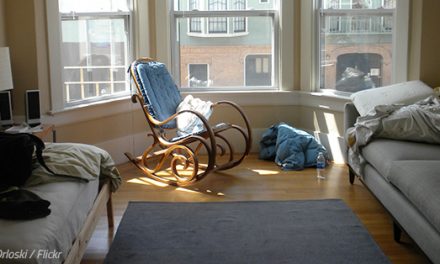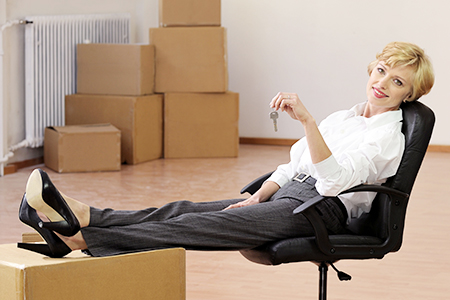
Moving out of a rental property shouldn’t be too complicated… as long as you follow a tenant move-out checklist.
There are a number of important things to do when moving out of a rental property. Your lease is ending and naturally, you’ll be worried about whether you’ll get back your security deposit.
There’s really no need to make things more complicated than necessary and that’s exactly why you’re going to need a tenant move out checklist – a detailed to-do list that will help you – the renter – to move out of the rental smoothly – that is, without any issues, conflicts, disputes or misunderstandings with the landlord.
In theory, you’re expected to do only a couple of things when moving out of a rental: 1) notify properly the landlord of your intention to move out and 2) leave the rental property in excellent condition – basically, the condition the apartment or house was when you rented it.
In practice, however, things are a bit more complicated than that and you’re going to have to use a good renter move out checklist to make sure the tenant turnover process gets to be as painless as possible for everyone.
Here are the top things to do when moving out of a rental property.
Check your lease agreement
As a tenant, you just have to know your responsibilities when you’re about to leave the rental property. And that is why one of the very first things you need to know when moving out of a rental is to read carefully your rental contract to understand how you should end the lease properly so that the move-out procedure goes as smoothly as possible.
What you need to do may vary depending on whether you have a month-to-month or a fixed-term rental agreement. Also, different rental agencies and property managers maintain different rules and requirements, and that’s exactly the reason why you should review your specific lease agreement.
What you should be most interested in is the advance period in which you are obliged to notify your landlord that you’re about to vacate the place – the standard vacate notice is usually one month. Another point of interest for you should be what exactly is expected of you when you’re moving out – most often, it’s about the condition in which you should leave the rented apartment or house.
And once you know what to do when moving out of a rental property, start working on those tasks ASAP so that you can guarantee a problem-free move-out scenario where each party is happy, with no disputes, misunderstandings, or hard feelings of any kind.
What to do before moving to a new home
Give a move out notice to your landlord
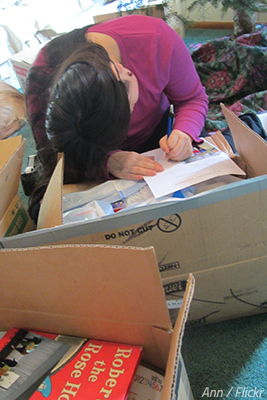
You did inform your landlord that you’re moving out, didn’t you?
As is the case with most rental agreements, your own rental contract will most likely require that you notify your landlord of your intention to move out 30 days before the move-out date. That move-out notice should be in writing – the so-called tenant move-out letter – and it should be sent to your landlord approximately 5 weeks before the date of the move.
The tenant move-out letter has to contain information about the specific date you intend to move out of the rental property, the address of the new place you’re moving to, and an explicit request to have your security deposit returned in full. Also, make sure you describe the excellent condition of the rental apartment or house that you’re moving out of.
If you happen to be moving out before your rental agreement expires, then you have to ask the landlord to break the lease. Don’t forget to include the specific reasons for leaving the place ahead of the agreed lease period.
10 Packing mistakes to avoid when moving
Pay up your bills
It goes without saying that you should take care of all unpaid bills before you move out of a rental. First of all, pay up all utility bills – electricity, water, gas, as well as any extra services such as cable TV, internet, phone, etc. Secondly, see if you owe any fees or charges such as management fees, and if you do, settle them too.
Make sure you keep all receipts as proof that you’ve paid up your bills diligently and within the set deadlines. As you should already know, the landlord has the right to use your security deposit to pay for any unpaid bills or charges, so making sure that you don’t have any outstanding payments will get you one step closer to getting your deposit money in full.
Also, remember to take the final meter readings on the day you move out and keep them in a safe place. In most cases, it’s best to take several clear close-up photos of them. If possible, turn on the date function of your digital camera when taking those shots.
20 Tips for moving long distance
Inspect the property for damage
Moving out of a rental property requires you to leave that rental place in the exact same condition that it was when you first moved in. During your stay there as a tenant, you may have caused some type of property damage that you may not even aware of. That is why, you have to inspect the property carefully for any signs of damage you may be responsible for, and if you do happen to find anything, you’re expected to fix it.
If you keep the condition report of the place from when you moved in, then the easiest way is to check it and compare it with how the rental property is right now, some weeks before you’re scheduled to move out. If you don’t have that condition report, then you should rely on your meticulous inspection of the entire place.
While normal wear and tear of the place is to be expected, you should be responsible for
- holes in the walls from hanging framed art,
- scratches or dents on the walls and floors, as well as broken tiles,
- tears, holes, stains or burn marks on carpets and curtains,
- stains on the walls,
- cracked or broken windows or mirrors,
- broken or missing light fixtures,
- damaged household appliances.
The brief tenant move out inspection checklist above should reveal existing problems, if any. Also, check the plumbing system for leaks or other types of damage and make sure the electrical system is working properly too.
Any damage you do find you should fix yourself or have it fixed by people who are authorized to do those repair works. Remember to document any repair works done on the rental property and keep the receipts as proof. In case of any permanent improvements to the property itself, you should request the repair costs to be deducted from the last rent payment.
How to deal with emotions when moving house
Clean the rental property
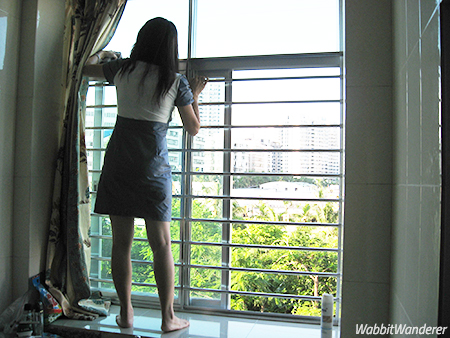
The rental property you’re leaving should be clean for the move-out inspection.
One of the most important things to do when moving out of a rental property is to make sure the place is thoroughly clean before you leave it. Understandably, there will be clauses in the rental agreement about leaving the rental unit as clean as possible – another step to getting back your security deposit without any problems whatsoever.
Chances are that you won’t enjoy the task of cleaning up the rental place you’re moving out of, but it’s just one of those things that you have to do to make the move-out process fairly stress-free for everyone.
Here’s a detailed tenant move out cleaning checklist you can follow:
Floors
- Mop all hardwood and tile floors;
- Vacuum all carpets;
- Remove any pet stains.
Walls
- Wash dirty areas around light switches, outlets, and vents;
- Remove cobwebs from ceilings and wall corners;
- Remove all hooks, screws, and nails, and patch the holes properly;
- Clean light fixtures, including ceiling fan blades;
- Repaint stained or damaged wall areas.
Windows
- Clean all windows inside and out, including the window sills;
- Dust all window blinds or screens, and wipe them clean, if necessary;
- Wash all curtains, if necessary.
Doors
- Wipe clean all doors, frames, and knobs.
Kitchen
- Clear any clogged drain pipes;
- Clean the sink and all countertops;
- Wipe clean all kitchen cabinets, including the shelves;
- Clean the cooking stove and oven using appropriate cleaners;
- Clean the refrigerator and dishwasher from the inside and outside.
Bathroom
- Clean and sanitize the toilet bowl, sink, shower, and bathtub;
- Clean all bathroom cabinets, drawers, shelves, and mirrors;
- Check if the toilet is working fine;
- Wash all tiles thoroughly;
- Clean all exhaust air fans.
Moving Checklist: What to do before moving out
Take photos of the rental place
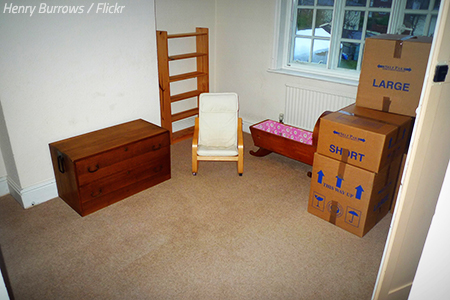
Take photos of the condition in which you’re leaving the rental unit.
One of the most important things to do when moving out of a rental property is to document the condition of the rental place so that you can present the evidence whenever needed.
- TAKE photos, plenty of photos of all the repair works you’ve completed, and after the house or apartment has been cleaned thoroughly. You may need to be able to prove that you’ve done your share of the deal in case of any disputes with the landlord over the security deposit.
- USE your smartphone to take short video clips as well, whenever needed – they will reinforce your position in case of disagreements later on.
- KEEP all receipts from the utilities and services you paid up, as well from the repair works you’ve paid for or the materials you had to buy to fix any damage. As already mentioned above, the landlord may agree to reimburse some of the money you spent on repairs that are viewed as a permanent improvement to the property.
Schedule a move out inspection
Your checklist for moving out of a rental property should end with you contacting your landlord and asking him or her to come over for a final walk-through inspection of the rental unit shortly before you move out. This is a critical stage of the move-out process, so do your best to be present at that move-out inspection together with your landlord in order to handle any potential discrepancies on the spot.
Use the presented opportunity to remind the landlord that they have to give you back the deposit money now that everything is exactly as it should be – you’ve given the landlord a move-out notice, you’ve cleaned thoroughly the place, and have made all necessary repairs to make the rental place look exactly as it did when you were moving in.
By scheduling a final walk-through of the place together with the landlord, you are insuring yourself that they will not have a good reason not to return the rental deposit back to you. It’s a smart way of urging the other party to fulfill their legal obligations once you’ve fulfilled yours.
Guide to moving to another state
Get back your security deposit
Finally, it’s time to get back the security deposit from your landlord and move away from that rental place. Bear in mind that you are legally entitled to get back your tenancy deposit back unless the landlord has a good reason to withhold part of it or the entire sum in case of property damage or violation of the terms of the lease agreement.
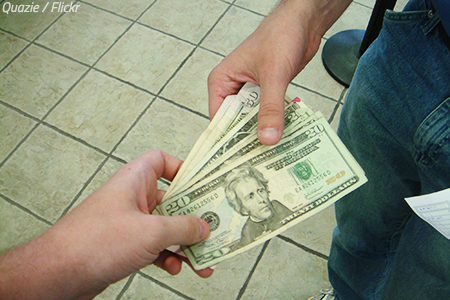
Getting back your security deposit will conclude the successful move-out scenario.
Ideally, you will get your rental deposit refunded before you move out rather than wait for it to be returned to you after you’re gone from the rental unit. If that’s an option, then send a written request to your landlord (use certified mail with return receipt request) and ask them to have your entire security deposit. Upon receiving the request, the landlord will have 2 to 3 weeks to either return your deposit money or send you a statement of deductions in case of any issues.
In case of any disputes or conflicts over the return of your security deposit, you should turn to a local housing organization or a tenant’s rights organization for assistance in settling the issue.
When moving out of a rental place, your main concern should be how to avoid property damage while moving out of the property. Remember that you need to leave the rental unit perfectly damage-free in order to collect your security deposit from your landlord.
So, are you confident that you will manage to leave the rental place perfectly intact with no zero damage to the floors (scratches, dents, broken tiles, etc.) or the walls (dents, marks, chips, etc.)? Do you have the necessary moving equipment (moving dollies, furniture sliders, moving blankets, moving straps, etc.) to prevent property damage on Moving day? Do you know how to use properly those pieces of moving equipment?
It’s best if you don’t risk inflicting costly property damage when moving out of your rental place. Instead, get quotes from experienced and insured professional moving companies to learn how much their quality moving services will cost you.









